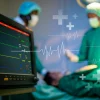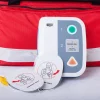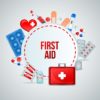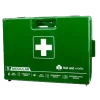
Recent Post
 Could You Recognise the Signs That Someone Needs a Defibrillator?
Could You Recognise the Signs That Someone Needs a Defibrillator?
September 12, 2023
Introduction
Did you know that sudden cardiac arrest (SCA) can strike anyone, anywhere, at any time? In fact, SCA is a leading cause of death globally, affecting millions of people each year. But here’s the good news: having an automated external defibrillator (AED. At home can significantly increase the chances of survival. In this blog, we’ll delve into the importance of keeping an AED at home and explore. The life-saving benefits it offers. So let’s dive in and discover why owning an AED is a decision that could truly make a difference.
Understanding Sudden Cardiac Arrest (SCA)
Before we delve into the benefits of having an AED at home. Let’s first understand what sudden cardiac arrest is and how it differs from a heart attack. SCA occurs when the heart’s electrical system malfunctions. Leading to a rapid and chaotic heartbeat. This abnormal rhythm is called ventricular fibrillation. Causes the heart to stop pumping blood effectively. Resulting in loss of consciousness and, if not treated promptly, death.
Unlike a heart attack, which occurs when a blocked artery restricts blood flow to the heart. SCA strikes suddenly and without warning. It can happen to individuals of all ages, even those with no history of heart disease. Every minute that passes without defibrillation reduces the chances of survival by 7-10%.
What is an Automated External Defibrillator (AED)?
An automated external defibrillator, commonly known as an AED. It is a portable device that delivers an electric shock to the heart. Which is to restore its normal rhythm during sudden cardiac arrest. Designed to be user-friendly, even for non-medical professionals. AEDs come equipped with clear instructions. And voice prompts to guide users through the defibrillation process.
The device consists of three main components: the pads, the computer, and the battery. The pads, which are placed on the chest of the person in cardiac arrest. Detect the heart’s rhythm and deliver the electric shock if necessary. The computer analyzes the heart’s rhythm and determines whether defibrillation is required. Lastly, the battery powers the AED, ensuring its readiness for immediate use.
Benefits of Having an AED at Home
Prompt Treatment and Increased Survival Rates
Time is of the essence when it comes to sudden cardiac arrest. The chance of survival decreases rapidly with each passing minute. However, when an AED is used within the first few minutes of cardiac arrest. The survival rate can increase from 5% to a staggering 75% or more.
Having an AED readily available at home. Means that you can initiate life-saving measures within seconds. By administering a shock to the heart, the AED can restore a normal rhythm. And increase the chances of survival until emergency medical services arrive.
Availability for Loved Ones and Visitors
Cardiac emergencies can strike anyone, including family members and visitors in your home. By having an AED on hand, you ensure that your loved ones. And those around you are protected in the event of sudden cardiac arrest. Prompt access to an AED can make all the difference between life and death.
Additionally, by having an AED at home, you can also play a vital role in your community. If a neighbour or someone nearby experiences cardiac arrest. You can quickly respond and potentially save a life.
Peace of Mind and Empowerment
The fear and helplessness that accompany emergencies can be overwhelming. However, by keeping an AED at home, you take control of the situation. You gain a sense of security. Knowing that you have the means to intervene effectively during a cardiac emergency.
Moreover, being trained in the use of an AED and having one at home empowers you to take immediate action. It eliminates the anxiety of waiting for medical professionals to arrive. And enables you to provide critical life-saving assistance to someone in need.
Overcoming Common Concerns and Barriers
While the benefits of having an AED at home are clear. Some concerns and barriers may prevent individuals from making this life-saving investment. Let’s address them:
Cost and Affordability
The cost of an AED may vary, but there are affordable options available in the market. Additionally, leasing programs and potential insurance coverage. Can make owning an AED more accessible and affordable for individuals and families.
Maintenance and Training
Maintaining an AED is relatively simple. Regularly checking the device’s battery and pads. As well as keeping them within their expiration dates, ensures that the AED is always ready for use. Training programs and resources are also widely available. Enabling you to acquire the necessary skills to use an AED effectively.
Legal Considerations
Some individuals may worry about potential legal implications. Or liability when using an AED. However, Good Samaritan laws exist to protect individuals. Who provides emergency assistance in good faith. These laws vary by jurisdiction. But they generally shield AED users from legal liability.
Conclusion
In conclusion, the importance of having an AED at home cannot be overstated. A sudden cardiac arrest is a life-threatening event that requires immediate intervention. And owning an AED significantly increases the chances of survival. By providing prompt treatment, and ensuring availability for loved ones and visitors. And offering peace of mind and empowerment, an AED becomes an invaluable addition to any home.
Don’t wait for a cardiac emergency to strike. Take the initiative to safeguard your family, friends. And community by considering the purchase of an AED for your home. By taking this proactive step, you become a beacon of hope. And a potential life-saver in the face of sudden cardiac arrest.
Frequently Asked Questions (FAQs)
How does an AED work?
An AED works by analysing the heart’s rhythm. And determining whether defibrillation is required. If a shock is necessary, the device delivers an electric current. Through the pads placed on the person’s chest. This shock helps restore the heart’s normal rhythm, increasing the chances of survival.
Can anyone use an AED?
Yes, AEDs are designed to be user-friendly, even for individuals without medical training. They come with clear instructions and voice prompts that guide users. Through the step-by-step defibrillation process. This accessibility allows anyone to effectively use an AED. And provide life-saving assistance during a cardiac emergency.
Do I need the training to use an AED?
While training is not a requirement to use an AED, it is highly recommended. Training programs provide valuable knowledge and hands-on practice. Enhancing your confidence and competence in using the device. Many organizations and community centres offer AED training courses. That teach proper usage techniques and CPR skills.
Are AEDs safe to use?
Yes, AEDs are safe to use. They are designed to analyze the heart’s rhythm accurately. And only deliver a shock when necessary. Additionally, the electric shock delivered by an AED is regulated. And controlled to ensure it is safe for the person receiving it. The device will not administer a shock. Unless it detects a specific abnormal rhythm that requires defibrillation.
Do AEDs require regular maintenance?
Yes, AEDs require regular maintenance to ensure their reliability and functionality. Basic maintenance tasks include checking the battery level. And expiration dates of the pads. Most AEDs have indicators or self-check features. Provide information on the device’s readiness. It is essential to follow the manufacturer’s guidelines. For maintenance and replace components as needed.
Can I be held legally responsible if I use an AED?
In most jurisdictions, individuals who use an AED in good faith. To assist someone in a cardiac emergency are protected by Good Samaritan laws. These laws provide legal protection and immunity from liability for those. Providing emergency medical assistance. However, it is important to familiarize yourself. With the specific laws and regulations in your jurisdiction. To ensure compliance and understand the extent of the legal protection offered.






